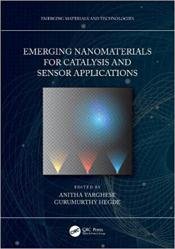 Название: Emerging Nanomaterials for Catalysis and Sensor Applications
Название: Emerging Nanomaterials for Catalysis and Sensor ApplicationsАвтор: Anitha Varghese, Gurumurthy Hegde
Издательство: CRC Press
Серия: Emerging Materials and Technologies
Год: 2023
Страниц: 301
Язык: английский
Формат: pdf (true)
Размер: 54.7 MB
This book reviews emerging nanomaterials in catalysis and sensors. The catalysis section covers the role of nano-photocatalysts in organic synthesis and health care application, oxidation and sulphoxidation reactions, liquid phase oxidation, hydrogen evolution and environmental remediation. It highlights the correlation of surface properties and catalytic activity of the mesoporous materials. The sensor section discusses the fabrication and development of various electrochemical, chemical, and biosensors.
Nanostructured materials have attracted intensive scientific attention because, at the nanoscale level, unique electrical, magnetic, optical and mechanical properties emerge. The size- dependent properties of nanostructured materials provide the highest potentials for increasing performance and extending their applications in many diverse fields, such as sensors, display technology, energy storage and energy conversion process, catalysis, pharmaceutical and biomedical. Sensors are devices that are frequently used to detect a variable quantity, commonly electronically, and sensors convert the measurement into specific signals. Utilization of nanostructured materials for sensor applications are technologically advantageous in terms of surface- to- volume ratio and high specific surface area, demonstrating strong potential in improving the performances of the sensors.
Up to now several nanostructured materials – 1D (nanowire, nanotube), 2D (nanosheets), and 3D (nanoparticles) – have been utilized as sensing materials for chemical, gas and biochemical detection applications. Among the various types of nanomaterials, specific types of nanomaterials – such as inorganic nanomaterials, metal oxides, carbon allotropic quantum dots, polymeric materials and organic- inorganic hybrid nanomaterials – are receiving ever- greater attention for sensor applications, because they can remarkably enhance response time, selectivity and sensitivity. As a result, the focus of this chapter is on the synthesis of nanomaterials using recently established techniques for sensor applications, fabrication of sensor devices and the sensing mechanisms involved in sensing various types of sensors, such as gas, chemicals and biosensors.
Two- dimensional (2D) materials are evolving as competitors for use in sensing devices in the Internet of Things (IoT) platform due to their favorable chemical and physical properties. Their large surface area- to- volume ratio implies that they are extremely sensitive to target substances. Due to their flexibility, high mechanical strength, and optical transparency, 2D material- based sensors can also be miniaturized. They interact with target molecules/ ions in two ways: physisorption and chemisorption.
Features:
Combines catalysis and sensor applications of nanomaterials, including detailed synthesis techniques of these materials.
Explores methods of designing, engineering, and fabricating nanomaterials.
Covers material efficiency, their detection limit for sensing different analytes and other properties of the materials.
Discusses sustainability of nano materials in the industrial sector.
Includes case studies to address the challenges faced by research and development sectors.
This book is aimed at researchers and graduate students in Chemical Engineering, Nanochemistry, Water Treatment Engineering and Labs, Industries, Research Labs in Catalysis and Sensors, Environmental Engineering, and Process Engineering.
Скачать Emerging Nanomaterials for Catalysis and Sensor Applications